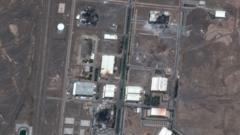Satellite imagery shared by BBC Verify has illustrated extensive damage at vital Iranian nuclear sites in Natanz and Isfahan, as well as missile launch sites within the region.
Satellite Imagery Unveils Damage to Iran's Nuclear Facilities

Satellite Imagery Unveils Damage to Iran's Nuclear Facilities
Recent satellite data indicates significant destruction at Iran's nuclear and missile sites.
Recent reports have emerged detailing the impact of military strikes on key Iranian infrastructure. Satellite images from Maxar showcase damage sustained at the Natanz nuclear facility, where the pilot fuel enrichment plant and an electrical substation were affected. The International Atomic Energy Agency (IAEA) confirmed that above-ground operations at this facility have faced destruction, impeding Iran's uranium enrichment efforts, crucial for both energy and nuclear armament.
Following initial assessments revealing strikes on locations in Iran, the IAEA's Rafael Grossi presented a briefing to the UN Security Council, mentioning that a significant portion of the plant responsible for producing uranium enriched up to 60% was irreparably damaged. Footage collected post-strike shows smoke billowing from the site, suggesting that penetrative munitions, known as "bunker busters," were likely deployed.
Additionally, the IAEA reported damage to critical buildings in Isfahan, indicating that the uranium conversion facility and the fuel plate fabrication plant were severely hit. While the satellite images indicated destruction in these areas, no rise in off-site radiation levels at Natanz or Isfahan has been recorded, providing a glimmer of assurance amid the chaos.
Moreover, analysis from Umbra Space has revealed destruction within missile complexes in Tabriz, showing damage to storage facilities and missile shelters. Satellite imagery from Planet Labs in Kermanshah also pointed to burn marks near a missile base, while verified footage showed plumes of smoke at the location. Maxar imagery has additionally indicated significant structural damage at the Ghadir ballistic missile base, raising concerns over Iran's military readiness amid escalating tensions in the region.
Following initial assessments revealing strikes on locations in Iran, the IAEA's Rafael Grossi presented a briefing to the UN Security Council, mentioning that a significant portion of the plant responsible for producing uranium enriched up to 60% was irreparably damaged. Footage collected post-strike shows smoke billowing from the site, suggesting that penetrative munitions, known as "bunker busters," were likely deployed.
Additionally, the IAEA reported damage to critical buildings in Isfahan, indicating that the uranium conversion facility and the fuel plate fabrication plant were severely hit. While the satellite images indicated destruction in these areas, no rise in off-site radiation levels at Natanz or Isfahan has been recorded, providing a glimmer of assurance amid the chaos.
Moreover, analysis from Umbra Space has revealed destruction within missile complexes in Tabriz, showing damage to storage facilities and missile shelters. Satellite imagery from Planet Labs in Kermanshah also pointed to burn marks near a missile base, while verified footage showed plumes of smoke at the location. Maxar imagery has additionally indicated significant structural damage at the Ghadir ballistic missile base, raising concerns over Iran's military readiness amid escalating tensions in the region.





















